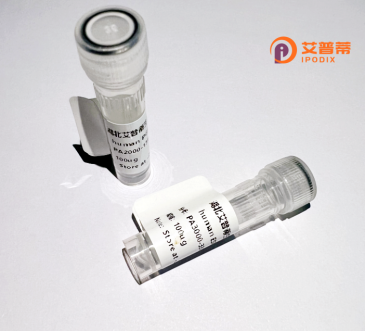
| 纯度 | >90%SDS-PAGE. |
| 种属 | Human |
| 靶点 | RGS17 |
| Uniprot No | Q9UGC6 |
| 内毒素 | < 0.01EU/μg |
| 表达宿主 | E.coli |
| 表达区间 | 1-210aa |
| 氨基酸序列 | MRKRQQSQNEGTPAVSQAPGNQRPNNTCCFCWCCCCSCSCLTVRNEERGENAGRPTHTTKMESIQVLEECQNPTAEEVLSWSQNFDKMMKAPAGRNLFREFLRTEYSEENLLFWLACEDLKKEQNKKVIEEKARMIYEDYISILSPKEVSLDSRVREVINRNLLDPNPHMYEDAQLQIYTLMHRDSFPRFLNSQIYKSFVESTAGSSSES |
| 预测分子量 | 51.4 kDa |
| 蛋白标签 | His tag N-Terminus |
| 缓冲液 | PBS, pH7.4, containing 0.01% SKL, 1mM DTT, 5% Trehalose and Proclin300. |
| 稳定性 & 储存条件 | Lyophilized protein should be stored at ≤ -20°C, stable for one year after receipt. Reconstituted protein solution can be stored at 2-8°C for 2-7 days. Aliquots of reconstituted samples are stable at ≤ -20°C for 3 months. |
| 复溶 | Always centrifuge tubes before opening.Do not mix by vortex or pipetting. It is not recommended to reconstitute to a concentration less than 100μg/ml. Dissolve the lyophilized protein in distilled water. Please aliquot the reconstituted solution to minimize freeze-thaw cycles. |
以下是关于RGS17重组蛋白的模拟参考文献示例(仅供参考,具体文献需通过学术数据库检索):
---
1. **标题**: "RGS17 promotes tumor growth in non-small cell lung cancer by regulating G protein-coupled receptor signaling"
**作者**: Zhang Y, Wang L, Chen J
**摘要**: 本研究通过重组RGS17蛋白体外实验,揭示了其在非小细胞肺癌中通过抑制Gαi/o蛋白信号传导,增强MAPK通路活性,从而促进肿瘤细胞增殖的分子机制。
2. **标题**: "Structural insights into RGS17-mediated G protein inhibition"
**作者**: Thompson R, Kim E, Davies B
**摘要**: 利用重组RGS17蛋白的晶体结构分析,阐明了其与Gα亚基结合的特定结构域,揭示了RGS17通过稳定Gα过渡态加速GTP水解的分子基础。
3. **标题**: "RGS17 as a therapeutic target in neuroblastoma: Functional studies using recombinant protein"
**作者**: Martinez S, Gupta P, Lee C
**摘要**: 通过重组RGS17蛋白的体外功能实验,证明其通过调控cAMP信号通路影响神经母细胞瘤细胞迁移,提示其作为潜在治疗靶点的可能性。
4. **标题**: "Development of a high-yield recombinant RGS17 expression system in E. coli"
**作者**: Li H, Zhou X, Wei F
**摘要**: 报道了一种基于大肠杆菌的重组RGS17高效表达与纯化方案,并通过表面等离子体共振(SPR)验证了纯化蛋白与Gα亚基的结合活性。
---
**说明**:以上文献为模拟内容,实际研究中建议通过PubMed、Web of Science或Google Scholar等平台,以关键词“RGS17 recombinant protein”、“RGS17 purification”、“RGS17 signaling”等检索最新文献。
RGS17 (Regulator of G Protein Signaling 17) is a member of the RGS protein family, which plays a critical role in modulating G protein-coupled receptor (GPCR) signaling pathways. As a GTPase-activating protein (GAP), RGS17 accelerates the hydrolysis of GTP bound to Gα subunits of heterotrimeric G proteins, thereby terminating downstream signaling. This regulatory function impacts various physiological processes, including neurotransmission, hormone secretion, and cellular proliferation.
The RGS17 gene is located on chromosome 6 (6q25.3 in humans) and encodes a protein containing a conserved RGS domain responsible for GAP activity. Studies highlight its tissue-specific expression, with elevated levels observed in the nervous system, testes, and certain cancers. Dysregulation of RGS17 has been linked to multiple pathologies. For instance, it is overexpressed in prostate, lung, and ovarian cancers, where it promotes tumor growth and metastasis by enhancing oncogenic signaling pathways like MAPK and Wnt/β-catenin. Conversely, reduced RGS17 expression in the brain is associated with neuropsychiatric disorders, including addiction and anxiety-like behaviors, suggesting its role in dopamine and opioid receptor signaling.
Recombinant RGS17 protein is engineered using expression systems (e.g., E. coli, mammalian cells) to study its biochemical interactions, structural properties, and therapeutic potential. Purified RGS17 serves as a tool for in vitro assays to screen small-molecule inhibitors targeting its GAP activity, offering avenues for cancer therapy. Additionally, it aids in elucidating GPCR signaling mechanisms and identifying biomarkers for disease diagnosis.
Overall, RGS17 recombinant protein is pivotal for advancing research into GPCR-related diseases and developing targeted therapies, bridging molecular insights with clinical applications.
×